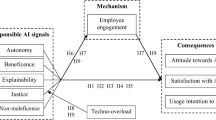Abstract
Nowadays artificial intelligence (AI) has been widely used in the healthcare industry. AI can provide improved healthcare services by advancing technologies and individuals expect AI’s human-like responses. This study aims to understand how the perceived humanness of AI influences individuals’ use intention of AI in health consultations. In view of the influencing mechanism model, this study carries out an in-depth study. This study develops a model to explore the relationship among perceived humanness, AI use intention, perceived values (utilitarian value and hedonic value), and perceived risk (PR). Meanwhile, it tests the mediating roles of perceived values and perceived risk on the relationship between perceived humanness and AI use intention. 275 university students were involved in this study. Results show that perceived utilitarian value and perceived hedonic value fully mediate the relationship, while perceived risk could not show a significant effect. This study shows evidence of why designing AI with perceived humanness increases users’ intention in health consultations.
Access this chapter
Tax calculation will be finalised at checkout
Purchases are for personal use only
Similar content being viewed by others
References
Väänänen, A., Haataja, K., Vehviläinen-Julkunen, K., Toivanen, P.: AI in healthcare: a narrative review. F1000Research 10, 6 (2021). https://doi.org/10.12688/f1000research.26997.1
Rietz, T., Benke, I., Maedche, A.: The impact of anthropomorphic and functional Chatbot design features in enterprise collaboration systems on user acceptance. International Conference on Wirtschafts informatik, pp. 1642–1656. Siegen, Germany (2019)
Westerman, D., Edwards, A.P., Edwards, C., Luo, Z., Spence, P.R.: I-it, I-thou, I-robot: the perceived humanness of AI in human-machine communication. Commun. Stud. 71(3), 393–408 (2020)
Zamora, J.: I’m sorry, dave, i’m afraid i can’t do that: Chatbot perception and expectations. In: Proceedings of the 5th International Conference on Human Agent Interaction, pp. 253–260 (2017)
Ahmad, N.A., Che, M.H., Zainal, A., Abd Rauf, M.F., Adnan, Z.: Review of Chatbots design techniques. Int. J. Comput. Appl. 181(8), 7–10 (2018)
Svenningsson, N., Faraon, M.: Artificial intelligence in conversational agents: a study of factors related to perceived humanness in chatbots. In: Proceedings of the 2019 2nd Artificial Intelligence and Cloud Computing Conference, pp. 151–161 (2019)
Babin, B.J., Darden, W.R., Griffin, M.: Work and/or fun: measuring hedonic and utilitarian shopping value. J. Consum. Res. 20(4), 644–656 (1994)
Belanche, D., Casaló, L.V., Schepers, J., Flavián, C.: Examining the effects of robots’ physical appearance, warmth, and competence in frontline services: the humanness-value-loyalty model. Psychol. Mark. 38(12), 2357–2376 (2021)
Jones, M.A., Reynolds, K.E., Arnold, M.J.: Hedonic and utilitarian shopping value: Investigating differential effects on retail outcomes. J. Bus. Res. 59(9), 974–981 (2006)
Wang, E.S.T.: Internet usage purposes and gender differences in the effects of perceived utilitarian and hedonic value. Cyberpsychol. Behav. Soc. Netw. 13(2), 179–183 (2010)
Chiu, C.M., Wang, E.T., Fang, Y.H., Huang, H.Y.: Understanding customers’ repeat purchase intentions in B2C e-commerce: the roles of utilitarian value, hedonic value and perceived risk. Inf. Syst. J. 24(1), 85–114 (2014)
Fiore, A.M., Jin, H.J., Kim, J.: For fun and profit: hedonic value from image interactivity and responses toward an online store. Psychol. Mark. 22(8), 669–694 (2005)
Chi, N.T.K., Hoang, V., N.: Investigating the customer trust in artificial intelligence: the role of anthropomorphism, empathy response, and interaction. CAAI Trans. Intell. Technol. 8(1), 260–273 (2023)
Akdim, K., Casaló, L.V., Flavián, C.: The role of utilitarian and hedonic aspects in the continuance intention to use social mobile apps. J. Retail. Consum. Serv. 66, 102888 (2022)
Kumar, V., Rajan, B., Venkatesan, R., Lecinski, J.: Understanding the role of artificial intelligence in personalized engagement marketing. Calif. Manage. Rev. 61(4), 135–155 (2019)
Gemünden, H.G.: Perceived risk and information search. a systematic meta-analysis of the empirical evidence. Int. J. Res. Mark. 2(2), 79–100 (1985). https://doi.org/10.1016/0167-8116(85)90026-6
Wu, J.H., Wang, S.: What drives mobile commerce?: an empirical evaluation of the revised technology acceptance model. Inf. Manage. 42(5), 719–729 (2005)
Rohden, S.F., Zeferino, D.G.: Recommendation agents: an analysis of consumers’ risk perceptions toward artificial intelligence. Electron. Commer. Res. 23(4), 2035–2050 (2023)
Author information
Authors and Affiliations
Corresponding author
Editor information
Editors and Affiliations
Rights and permissions
Copyright information
© 2024 The Author(s), under exclusive license to Springer Nature Switzerland AG
About this paper
Cite this paper
Xia, T., Kong, X., Mai, Q., Guo, H., Liu, X. (2024). Why Does Perceived Humanness Predict AI Use Intention? The Mediating Roles of Perceived Values and Perceived Risk. In: Tu, Y.P., Chi, M. (eds) E-Business. New Challenges and Opportunities for Digital-Enabled Intelligent Future. WHICEB 2024. Lecture Notes in Business Information Processing, vol 516. Springer, Cham. https://doi.org/10.1007/978-3-031-60260-3_8
Download citation
DOI: https://doi.org/10.1007/978-3-031-60260-3_8
Published:
Publisher Name: Springer, Cham
Print ISBN: 978-3-031-60259-7
Online ISBN: 978-3-031-60260-3
eBook Packages: Computer ScienceComputer Science (R0)




